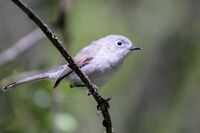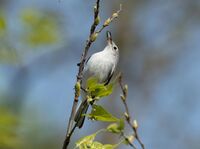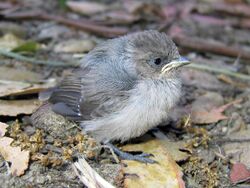Biology:Blue-gray gnatcatcher
| Blue-gray gnatcatcher | |
|---|---|
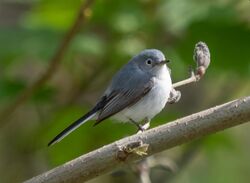
| |
| File:Polioptila caerulea - Blue-grey Gnatcatcher XC178132.mp3 | |
| Call recorded in Minnesota | |
| Scientific classification | |
| Domain: | Eukaryota |
| Kingdom: | Animalia |
| Phylum: | Chordata |
| Class: | Aves |
| Order: | Passeriformes |
| Family: | Polioptilidae |
| Genus: | Polioptila |
| Species: | P. caerulea
|
| Binomial name | |
| Polioptila caerulea (Linnaeus, 1766)
| |
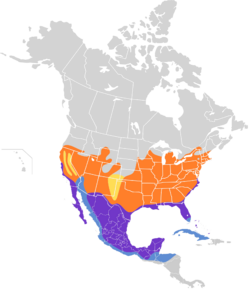
| |
| Geographical distribution of blue-gray gnatcatcher Breeding Year-round Nonbreeding Nonbreeding (scarce)
| |
| Synonyms | |
|
Motacilla caerulea Linnaeus, 1766 | |
The blue-gray gnatcatcher(Polioptila caerulea) is a very small songbird native to North America.
Description
It is 10–13 cm (3.9–5.1 in) in length, 6.3 in (16 cm) in wingspan,[2] and weighing only 5–7 g (0.18–0.25 oz).[3][4] Adult males are blue-gray on the upperparts with white underparts, slender dark bill, and a long black tail edged in white. Females are less blue, while juveniles are greenish-gray. Both sexes have a white eye ring.
Distribution and habitat
The blue-gray gnatcatcher's breeding habitat includes open deciduous woods and shrublands in southern Ontario, the eastern and southwestern United States, and Mexico. Though gnatcatcher species are common and increasing in number while expanding to the northeast,[5][full citation needed] it is the only one to breed in Eastern North America. They migrate to the southern United States, Mexico, northern Central America (Belize, Guatemala, and Honduras), Cuba, the Bahamas, the Turks and Caicos Islands, and the Cayman Islands.
Diet and behaviour
These birds prefer humid areas with large leaves, woodlands, and more open sandy areas with sparse trees where they mainly eat insects, insect eggs, and spiders. The males often work to build nests, help incubate and raise the young, as well as feed the children, often thought to be a mother's role. Their nests are often built far out on a tree's branch with spider silks and lichen plants holding them together.[6] They may hover over foliage while snatching prey (gleaning), or fly to catch insects in flight (hawking). The tail is often held upright while defending territory or searching for food.[7]
Sounds
The songs (and calls) are often heard on breeding grounds, (usually away from nest) and occasionally heard other times of the year. Calls: "zkreee, zkreee, zkreee", Songs: "szpree zpree spreeeeey spree spre sprzrreeeee"
Breeding
Both parents build a cone-like nest on a horizontal tree branch, and share feeding the young. The incubation period is 10-15 days for both sexes, and two broods may be raised in a season.[8]
Blue-gray gnatcatcher nest made of lichens, hair, and spiderwebs |
References
- ↑ BirdLife International (2016). "Polioptila caerulea". IUCN Red List of Threatened Species 2016: e.T22711581A94302237. doi:10.2305/IUCN.UK.2016-3.RLTS.T22711581A94302237.en. https://www.iucnredlist.org/species/22711581/94302237. Retrieved 13 November 2021.
- ↑ "Blue-gray Gnatcatcher Identification, All About Birds, Cornell Lab of Ornithology" (in en). https://www.allaboutbirds.org/guide/Blue-gray_Gnatcatcher/id.
- ↑ "Blue-gray Gnatcatcher". All About Birds. Cornell Lab of Ornithology. http://www.allaboutbirds.org/guide/Blue-gray_Gnatcatcher/id.
- ↑ "Blue-gray Gnatcatcher Polioptila caerulea". http://www.enature.com/fieldguides/detail.asp?recNum=BD0261.
- ↑ Greenberg, Russell (2001). Birds of North America. Sean Moore.
- ↑ González-García, Fernando (2020). "First record of non-migratory Blue-gray Gnatcatcher (Polioptila caerulea) as a host to the Bronzed Cowbird (Molothrus aeneus) in Mexico". The Wilson Journal of Ornithology. https://doi.org/10.1676/20-96.
- ↑ "Blue-gray Gnatcatcher" (in en). https://www.natureweb.net/taxa/birds/bluegraygnatcatcher.
- ↑ "Blue-gray Gnatcatcher" (in en). 2014-11-13. https://www.audubon.org/field-guide/bird/blue-gray-gnatcatcher.
External links
- Blue-gray gnatcatcher - Polioptila caerula - USGS Patuxent Bird Identification InfoCenter
- Blue-grey gnatcatcher stamps[Usurped!] from Turks and Caicos at bird-stamps.org[Usurped!]
- "Blue-grey gnatcatcher media". Internet Bird Collection. http://www.hbw.com/ibc/species/blue-grey-gnatcatcher-polioptila-caerulea.
- Blue-gray gnatcatcher photo gallery at VIREO (Drexel University)
- Blue-gray gnatcatcher Bird Sound at Florida Museum of Natural History
- BirdLife species factsheet for Polioptila caerulea
- "Polioptila caerulea". Avibase. https://avibase.bsc-eoc.org/species.jsp?lang=EN&avibaseid=.
Wikidata ☰ Q883006 entry
 |


